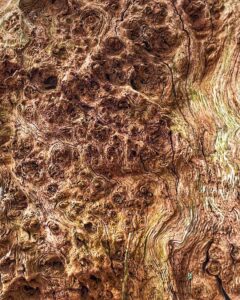When I was a lad, I remember a Saturday morning BBC Radio programme called Children’s Favourites. One of the songs frequently played was I Know an Old Lady Who Swallowed a Fly, sung by an American named Burl Ives. I thought Burl was an cool name.
At the time, I had no idea that ‘burl’ is the American term for those unsightly, knotted growths found on tree trunks and branches. In English, they are called ‘burrs’. These lumpy protrusions are the result of uncontrolled, erratic growth beneath the bark, creating a dense, irregular wood grain.
A tree may produce a burr for various reasons, none of them particularly pleasant. Possible causes include:
- Physical injury, such as damage from high winds, insects, squirrels, or deer.
- Infections caused by bacteria, fungi, or viruses, which interfere with cell division.
- Environmental stress, including extreme weather and pollution.
- Somatic mutations, for those who like their biological jargon.
In most cases, a burr does not harm the tree, though if it forms on a branch, it may grow so heavy that the branch snaps off. If it develops in response to injury, it might even serve a protective function—nature’s crude attempt at a bandage.
Some tree species are more prone to these grotesque formations than others. Oaks, maples, walnut, and birch are frequent victims. Livestock rubbing against a tree over many years can encourage burr development, sometimes leading to a ‘skirted tree’, where the burr encircles the trunk. If such a tree is found in woodland or a hedge, it suggests the area was once used as pasture.

Though burrs are rather unsightly on the outside, their chaotic internal grain makes them highly sought after by woodworkers. They are used to craft bowls, furniture, musical instruments, and sculptures. However, cutting a burr from a living tree is generally ill-advised, so they are typically salvaged from dead or fallen trees instead.
In the main photo, the branch on the left is dead, and its burr has shed its bark, exposing the swirling, contorted grain beneath—a tangle of browns and tans, punctuated by deep crevices and raised ridges. A fitting testament to nature’s talent for creating something both resilient and misshapen.

Leave a Reply